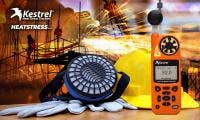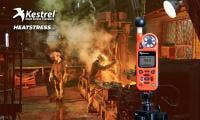Combating Heat Stress in Military Training: Understanding WBGT and Heat Safety

Heat stress is a critical concern during military training, where physically demanding tasks, heavy gear, and extreme environmental conditions can put soldiers at risk. Without proper precautions, heat-related illnesses such as heat exhaustion or heat stroke can compromise safety and derail training objectives.
To mitigate these risks, military units rely on tools like the Kestrel Heat Stress Flag Kit to establish WBGT (Wet Bulb Globe Temperature) zones and enforce heat safety protocols during training exercises.
Heat Stress Risks in Military Training

Military training environments often include high-temperature scenarios that amplify the risk of heat stress. Whether on obstacle courses, in fitness tests, or during outdoor drills, soldiers face unique challenges due to:
- Heavy Gear: Wearing full uniforms and carrying equipment increases heat retention and physical exertion.
- High Activity Levels: Strenuous activities like running, marching, or climbing demand continuous exertion in challenging conditions.
- Outdoor Exposure: Prolonged exposure to sun, humidity, and wind raises the likelihood of heat-related illnesses.
Without proper heat stress management, soldiers may experience dehydration, fatigue, and reduced performance, leading to greater risks during critical exercises.
What Is WBGT, and Why Does It Matter?
WBGT, or Wet Bulb Globe Temperature, is the most comprehensive measurement of heat stress. It accounts for multiple environmental factors:
- Air Temperature: The baseline temperature in the environment.
- Humidity: The level of moisture in the air, which affects sweat evaporation.
- Solar Radiation: The sun’s intensity, which increases heat absorption.
- Wind Speed: Air movement that impacts cooling.
The Role of the Kestrel Heat Stress Flag Kit

The Kestrel Heat Stress Flag Kit is a simple, effective tool for visualizing heat stress zones in real-time. It pairs seamlessly with WBGT monitoring devices, such as the Kestrel 5400 Heat Stress Tracker, to help military trainers and commanders enforce safety protocols.
How It Works:
- Color-Coded Flags: Each flag represents a WBGT zone.
- Portable and Durable: Designed to withstand rugged training environments.
- Easy Deployment: Quickly set up the flags in outdoor training areas to keep all personnel informed.
With the Kestrel Heat Stress Flag Kit, military trainers can communicate heat stress conditions at a glance, ensuring soldiers know when to hydrate, rest, or adjust activity levels.
Why Proactive Heat Stress Management Matters in Training
Implementing heat stress management tools like WBGT monitoring and flag systems offers several benefits:
- Reduced Heat-Related Illnesses: Prevent incidents of heat exhaustion and heat stroke during training.
- Improved Training Outcomes: Maintain soldier performance and focus under challenging conditions.
- Increased Awareness: Ensure all personnel understand and comply with heat safety protocols.
Prioritize Heat Safety in Military Training

As heat stress risk grow, military training environments require proactive safety measures. The Kestrel Heat Stress Flag Kit, combined with WBGT monitoring, is an essential tool for keeping soldiers safe, healthy, and ready to perform at their best.







